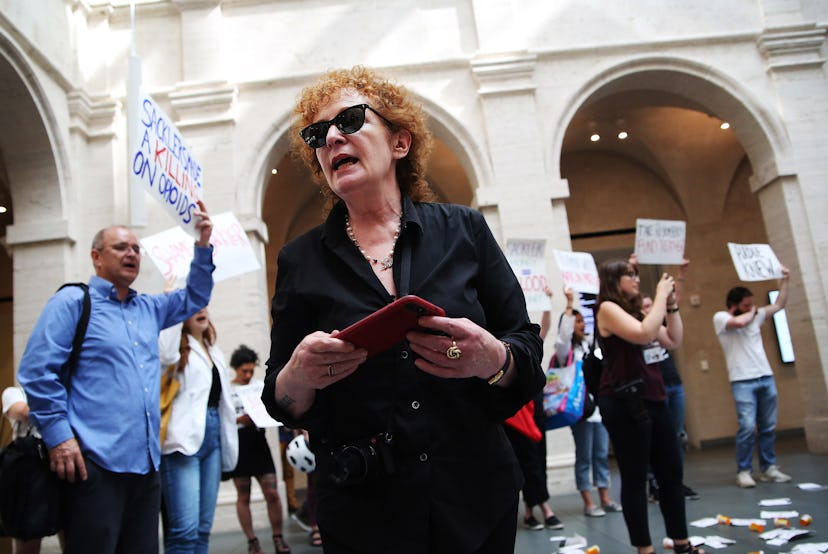Nan Goldin Was Arrested for Protesting the Opioid Crisis Outside of Governor Cuomo’s Office

The artist Nan Goldin is no stranger to controversy; in 1997, for example, then president Bill Clinton publicly accused her of promoting the aesthetic known as “heroin chic” through her photography. Decades later, Goldin is still making trouble—though in recent years, for a much different reason than capturing raw, unapologetic images of life in New York in the 1980s. Since 2017, Goldin has dedicated herself to combatting the opioid crisis, from staging die-ins in museums around the world to repeatedly calling out one of the country’s richest and most influential families.
Before she announced as much, Goldin had been largely absent from the art world for nearly three years. As it turned out, it was also nearly three years that Goldin didn’t even leave her house, having developed an addiction to the OxyContin she’d been prescribed for her tendonitis. Having recovered, Goldin founded Prescription Addiction Intervention Now (P.A.I.N.), which is still active as ever today in fighting the epidemic.
As for how active, well, on Wednesday, Goldin and 12 other P.A.I.N. members were arrested outside of New York governor Andrew Cuomo’s office in Manhattan, where they’d been protesting Cuomo’s failure to establish overdose prevention centers. To get the message across, they’d linked arms and held a banner: “GOVERNOR WHILE YOU WAIT NEW YORKERS DIE.”
The number of deaths related to opioid overdose—on average, now 130 each day—in the U.S. have increased nearly six times since 1999. (That’s thanks in large part to Goldin’s two main targets: the Sackler family and Purdue Pharma. In 2017, the number of opioid overdose-related deaths was more than 47,000, of which more than a third involved prescriptions. As for how routinely opioids are still prescribed, in 2015, enough pills were dispensed in Oklahoma to supply 110 pills to each and every adult living in the state.
Oklahoma is just an example, but one that’s particularly relevant this week: Two days before Goldin’s arrest, a state court ordered Johnson & Johnson to pay $572 million for its history of downplaying the dangers of opioids with “false, misleading, and dangerous marketing.” And that’s just the tip of the iceberg: the Johnson & Johnson lawsuits was only the first of thousands brought against opioid distributors and manufacturers to go to trial.
No doubt, this is still just the beginning for Goldin, too. After all, in the less than two years since she took on the Sacklers and Purdue Pharma, giving the art world a wakeup call about some of its most prominent benefactors, the Metropolitan Museum of Art, the National Portrait Gallery, the American Museum of Natural History, and the Tate have all pledged to cut fundraising ties with the Sacklers in support of the cause.
Related: Jamie Lee Curtis Reveals Her Past Struggles With Opioid Addiction
Nan Goldin’s Notorious New York of the 80’s, Revisited
“Nan and Brian in Bed, New York City,” 1983. Silver dye bleach print, printed 2006. The Museum of Modern Art, New York. © 2016 Nan Goldin.
“The Hug, New York City,” 1980. Silver dye bleach print, printed 2008. The Museum of Modern Art, New York. © 2016 Nan Goldin.
“Trixie on the Cot, New York City,” 1979. Silver dye bleach print, printed 2008. The Museum of Modern Art, New York. © 2016 Nan Goldin.
“Buzz and Nan at the Afterhours, New York City,” 1980. Silver dye bleach print, printed 2008. The Museum of Modern Art, New York. © 2016 Nan Goldin.
“Nan and Dickie in the York Motel, New Jersey,” 1980. Silver dye bleach print, printed 2008. The Museum of Modern Art, New York. © 2016 Nan Goldin.
“Rise and Monty Kissing, New York City,” 1980. Silver dye bleach print, printed 2008. The Museum of Modern Art, New York. © 2016 Nan Goldin.
“Nan One Month After Being Battered,” 1984. Silver dye bleach print, printed 2008. The Museum of Modern Art, New York. © 2016 Nan Goldin.
“David and Butch Crying at Tin Pan Alley, New York City,” 1981. Silver dye bleach print, printed 2009. The Museum of Modern Art, New York. © 2016 Nan Goldin.
“C.Z. and Max on the Beach, Truro, Massachusetts,” 1976. Silver dye bleach print, printed 2006. The Museum of Modern Art, New York. © 2016 Nan Goldin.
“The Parents’ Wedding Photo, Swampscott, Massachusetts,” 1985. Silver dye bleach print, printed 2006. The Museum of Modern Art, New York. © 2016 Nan Goldin.
“Philippe H. and Suzanne Kissing at Euthanasia, New York City,” 1981. Silver dye bleach print, printed 2008. The Museum of Modern Art, New York. © 2016 Nan Goldin.
“Max and Richard, New York City,” 1983. Silver dye bleach print, printed 2006. The Museum of Modern Art, New York. © 2016 Nan Goldin.
“Nan on Brian’s Lap, Nan’s Birthday, New York City,” 1981. Silver dye bleach print, printed 2008. The Museum of Modern Art, New York. © 2016 Nan Goldin.